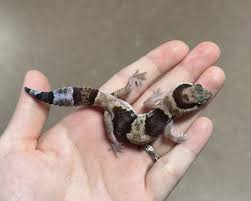GECKO ABERRANT FAT TAILED (Hemitheconyx caudicinctus)
$250.00
Full Description
Here is a complete Aberrant African Fat-Tailed Gecko (Hemitheconyx caudicinctus) care guide. The “aberrant” term refers to unusual or broken banding patterns—a cosmetic trait seen in many morphs of fat-tails. These geckos are calm, hardy, and relatively easy to care for.
Aberrant African Fat-Tailed Gecko Care Guide
Morph Overview
| Trait | Description |
|---|---|
| Common Name | Aberrant Fat-Tailed Gecko |
| Scientific Name | Hemitheconyx caudicinctus |
| Morph Type | Pattern morph (broken or irregular banding) |
| Experience Level | Beginner-friendly |
Size & Lifespan
| Feature | Typical Range |
|---|---|
| Adult Length | 7–9 inches (18–23 cm) |
| Adult Weight | 45–75 grams |
| Lifespan | 15–20+ years in captivity |
Enclosure Setup
Enclosure Size
| Stage | Recommended Size |
|---|---|
| Juvenile | 10–15 gallons |
| Adult | 20-gallon long (minimum) |
Fat-tails are terrestrial and prefer more floor space than height.
Substrate Options
| ✅ Safe | ❌ Unsafe |
|---|---|
| Paper towels | Loose sand |
| Reptile carpet | Bark, coconut coir |
| Tile or slate | Calcium or walnut shell |
| Bioactive (for advanced keepers) | Gravel or soil mixes with perlite |
️ Temperature & Humidity
| Zone | Temp (°F) | Temp (°C) |
|---|---|---|
| Warm side | 88–92°F | 31–33°C |
| Cool side | 75–80°F | 24–27°C |
| Nighttime | 70–75°F | 21–24°C |
| Humidity | 50–70% | Higher than leopard geckos |
Use an under-tank heater (UTH) with a thermostat
Use a humid hide on the warm side with sphagnum moss
Monitor humidity with a digital hygrometer
Lighting
-
UVB is optional, but 2–5% UVB may be beneficial
-
Use a 12-hour light/dark cycle
-
Natural ambient light is sufficient if enclosure is in a bright room
-
Avoid strong overhead lights; fat-tails are crepuscular/nocturnal
️ Decor & Hides
| Item | Purpose |
|---|---|
| Warm hide | Thermoregulation |
| Cool hide | Rest and safety |
| Humid hide | Essential for shedding |
| Ground clutter | Rocks, logs, leaf litter |
| Plants (optional) | Enrichment, visual barriers |
Feeding & Supplementation
Feeder Insects
| Feeder | Notes |
|---|---|
| Crickets | Staple, active and engaging |
| Dubia roaches | Excellent staple, high protein |
| Mealworms | Easy to feed, use in moderation |
| Superworms | Use occasionally (high fat) |
| BSFL/Waxworms | Treats only |
Feeding Schedule
| Age | Frequency |
|---|---|
| Juvenile | Daily |
| Adult | Every 2–3 days |
Supplements
| Supplement | Frequency |
|---|---|
| Calcium (no D3) | Available in dish |
| Calcium + D3 | 1–2× per week |
| Multivitamin | 1× per week |
✅ Always gut-load insects 24–48 hrs before feeding
Cleaning Routine
| Task | Frequency |
|---|---|
| Spot clean waste | Daily |
| Water dish | Refresh daily |
| Full substrate change | Monthly (non-bioactive) |
| Deep clean hides & decor | Monthly or as needed |
Morph Notes: Aberrant Pattern
| Trait | Details |
|---|---|
| Pattern Type | Broken or uneven bands (non-symmetrical) |
| Effect on Health | Cosmetic only—no known issues |
| Common Pairings | May be seen with Amel, Zulu, Whiteout, Patternless |
| Genetics | Often polygenic (line-bred), but can also occur randomly |
Handling Tips
-
Very docile species—great for beginners
-
Wait 1–2 weeks before handling after rehoming
-
Handle 5–10 mins a few times per week
-
Always support the entire body
-
Avoid handling during shed or right after feeding
✅ Quick Reference Chart
| Feature | Recommendation |
|---|---|
| Tank Size | 20 gal long (minimum for adults) |
| Substrate | Paper towels, tile, or bioactive |
| Heat | UTH with thermostat |
| Temp Gradient | 88–92°F (warm), 75–80°F (cool) |
| Humidity | 50–70%, moist hide essential |
| Lighting | UVB optional (low output) |
| Feeding | Gut-loaded insects + supplements |
| Behavior | Calm, slow-moving |

